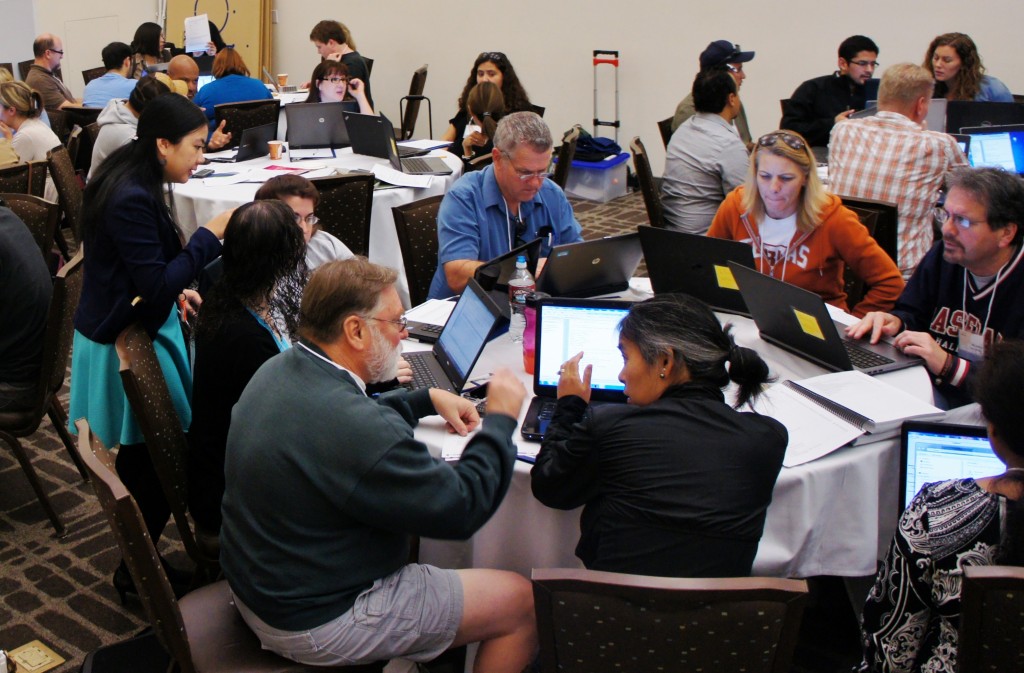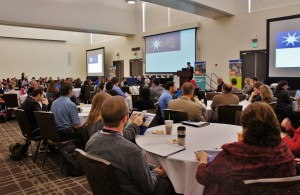All breakout sessions are tentative and still subject to change. Last updated 2/1/2021.
Session |
Session Title and Description |
Focus |
|---|---|---|
Session 2 9:00 am – 9:50 am PST |
||
| 2A |
Hands-on: Getting Started with Coding and Robotics for Teaching CS/STEAM and Math for the Absolute BeginnerFacilitator: Jeff Hescox, C-STEM Program Manager, UC Davis C-STEM Learn how to get started with C-STEM coding and robotics from the very beginning. This session will cover an overview of the C-STEM program and provide first-hand experience on getting started on your own computer. Experience how easy it is to set up and how fun it can be to learn through coding and robotics. |
|
| 2B |
Hands-on: Arduino for Electronics, Physical Computing, and Sensor-Based RoboticsFacilitator: Dr. Larry Lagerstrom, Chief Academic Officer, Barobo, Inc. Arduino is the most popular Do-It-Yourself (DIY) platform for simple electronics and robotics. This session will explore Arduino and how it can be used to teach students math, science, engineering, and technology with simple circuitry, creative problem solving, and physical computing. |
|
| 2C |
C-STEM Program: IHE/K-12/Industry Partnership on Transforming Math and CS Education with 13-Years Hands-on Coding and RoboticsPresenters: C-STEM provides K-12 students with 13 years of hands-on integrated math and computer science education in compliance with both Common Core Math and CS Standards. Join this panel session to learn the strategies to integrate programming and robotics into K-12 CS, STEAM, and CTE curriculum to close the math achievement gap with C-STEM. You will also learn about the C-STEM RoboPlay Competition and GIRL/GIRL+ Summer Camps. Learn from experienced teachers and administrators on how to design integrated STEM pathways into their master schedule for students to find success. What are some strategies to ensure sustainability of STEM pathways at your school site and how can local funding be used for implementation of the C-STEM program? How can STEM programs help leverage student success for ALL students? Join this session for a candid discussion on implementing STEM programs in your school. |
|
Session 3 10:00 am – 10:50 am PST |
||
| 3A |
Hands-on: Teaching K-5 Mathematics with RoboticsFacilitators: Participants will be guided through hands-on examples using coding and robotics to teach grades K-5 math. Participants will discover how coding and robotics directly support students’ math, critical thinking, and problem solving skills in a unique, engaging way. Try our hands-on approach to counting numbers, adding, subtracting, recognizing mathematical constructs, 2 and 3 dimensional geometry, etc. This session will also explore how C-STEM is currently being used in grades K-5 classes.
|
|
| 3B |
Hands-on: Teaching Secondary CS/STEAM with RoboticsFacilitator: Brian Carnes, Computer Science Teacher, Desert Ridge Academy, Desert Sands Unified School District The CS/STEAM with Robotics curriculum motivates and engages students in learning fundamentals of computer science (CS), science, technology, engineering, art, and mathematics (STEAM) by using hands-on interactive robotics lessons and activities with virtual and/or hardware robots. |
|
| 3C |
Counseling for Students to Succeed in STEMPresenters: This session will give counselors a brief introduction to coding, robotics, and computer science and show how these hands-on activities are related to core academic programs of math and science. Join this session to learn how to advise students to take C-STEM related courses. |
|
Session 4 11:00 am – 11:50 am PST |
||
| 4A |
Hands-on: Teaching K-5 CS/STEAM with RoboticsFacilitator: Margaret Elliott, C-Stem Teacher, Foothill Middle School, Mt. Diablo Unified School District Participants will be guided through hands-on examples to teach grades K-5 CS/STEAM with Robotics. Participants will discover how coding and robotics directly support students’ critical thinking and problem solving skills. The CS/STEAM with Robotics curriculum motivates and engages students in learning fundamentals of computer science (CS), science, technology, engineering, art, and mathematics (STEAM) by using hands-on interactive robotics lessons and activities with virtual and/or hardware robots. |
|
| 4B |
Hands-on: Teaching Secondary Mathematics with RoboticsFacilitator: Jeff Hescox, C-STEM Program Manager, UC Davis C-STEM An experienced C-STEM teacher will guide participants through hands-on examples using coding and robotics to teach secondary math. Participants will discover how coding and robotics directly support students’ math, critical thinking, and problem solving skills in a unique, engaging way. This session will also explore how C-STEM is currently being used in secondary school math classes. |
|
| 4C |
Teaching & Learning with C-STEM and How It Relates to Math Standards and Standards of Mathematical Practices (the same as 6C)Presenters: The C-STEM Math-ICT Curriculum explores mathematical concepts in the Common Core State Standards through practical applications with hands-on computing, engineering, and robotics activities. The hands-on computing, engineering, and robotics activities help students make meaningful connections between abstract math concepts and real-life applications. Join this session for demonstration of how coding and robotics can be used to teach CCSS Math Standards and Standards of Mathematics Practices at different grade levels. Learn how the C-STEM Math curriculum can be implemented as both regular and supplementary courses, and how its engagement with students has a great impact. |
|
Session 5 1:00 pm – 1:50 pm PST |
||
| 5A |
Hands-on: Creating Your Own Lessons and Activities in RoboBlocklyFacilitator: Dr. Larry Lagerstrom, Chief Academic Officer, Barobo, Inc. Ever thought about creating your own lessons and activities with coding and robotics? This hands-on session shows how teachers can easily design their own lessons and activities for their students. Teachers can start from scratch or remix existing activities to meet their students’ needs. This session will put the teacher behind the scenes and allow them to be their own developer. |
|
| 5B |
Hands-on: Integrating Art (Drawing, Image, Animation, Music) into Math EducationFacilitator: Jeff Hescox, C-STEM Program Manager, UC Davis C-STEM This session shows how the C-STEM program integrates Art into STEAM education by giving students the opportunity to explore their artistic and creative talents through activity resources for music, drawing and animating with coding, programming hardware robots to play melodies, learning math with a piano, and generating a gallery of graphics. |
|
| 5C |
Strategy, Pedagogy, and Experience on Teaching Math/CS/STEAM with Coding and RoboticsModerator: Presenters: Greg Miller, 3rd Grade Teacher, McPherson K-8 Magnet School, Orange USD In this discussion, experienced educators will discuss strategies and pedagogy as they relate to interdisciplinary learning. By utilizing project-based learning, teachers can facilitate learning on a holistic level for students while meeting subject-based standards. Join this session to learn how to teach Math/CS/STEAM with coding and robotics. |
|
Session 6 2:00 pm – 2:50 pm PST |
||
| 6A |
Hands-on: Creating Animations in RoboBlocklyFacilitator: Allen Thoe, High School Math and CS Teacher, Redlands Unified School District Ever wonder how animation works? In this hands-on session, learn how your students can allow their creativity to drive their learning by animating. RoboBlockly allows for students and teachers to easily create stories with animations, characters, backdrops, and movement. Start creating your first animation while learning how to code. |
|
| 6B |
Hands-on: Introduction to C-STEM Studio, RoboSim, and Coding in Ch/C/C++Facilitator: Jeff Hescox, C-STEM Program Manager, UC Davis C-STEM In this hands-on session, participants will experience C-STEM Studio, a user-friendly platform for learning STEM in C using a user friendly C/C++ interpreter Ch. C-STEM Studio is integrated with innovative educational computing and robotics technologies for learning STEM subjects. Participants will be introduced to RoboSim, a robot simulation environment for programming Linkbots. |
|
| 6C |
Teaching & Learning with C-STEM and How It Relates to Math Standards and Standards of Mathematical Practices (the same as 4C)Presenters: How can C-STEM robotics and computer science enhance the teaching of mathematics? Join this session to learn more about how standards of mathematical practice are embedded in the C-STEM Curriculum. Learn how hands-on robotics allows for students to be engaged in interdisciplinary learning while excelling in Common Core math standards. |


